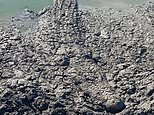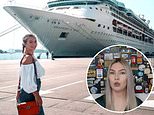
You have the eyes of a hawk if you can see this sinister predator lurking in the mudViral picture shows a master of camouflage The native Australian reptile is barely visible in the mud
Australia has a reputation for dangerous native animals and while in some cases it’s an urban myth played up for tourists, in other instances the warnings are justified.
A viral picture snapped in North Queensland and recently shared online is a perfect example, with any unsuspecting visitor wandering by hard-pressed to spot the creature against the bush backdrop.
But amid the mud, dirt and rocks on the banks of this waterway lies a huge deadly reptile whose powerful jaws can clamp down with a force greater than an industrial car crusher.
The massive crocodile is barely visible underneath the mud on the banks of the tropical north Queensland waterway (pictured)
The outline of the massive crocodile can be made out below the mud, its head facing the shoreline and tail disappearing into the murky water.
According to National Geographic, researchers have measured the bite of the saltwater crocodile at 3,700 pounds per square inch (PSI) which it the most powerful of any land animal.
By contrast, lions generate about 1,000psi in bite force and most industrial car crushers – massive hydraulic pistons that demolish cars into cubes – need about 2,000psi to do their job.
According to CrocWise, a safety site based in tropical North Queensland, crocs in the area can grow up to six metres long – nearly 20 feet – and can hold their breath underwater for an hour-and-a-half.
According to one local from Cairns who shared the picture, a crocodile’s ‘whole method of hunting is their prey not being able to tell when they are close.’
‘I live in a saltwater crocodile habitat and the rule we tend to go by is that if a body of water is big enough to hide a crocodile then assume there is one hidden in it and treat it with respect,’ the local said
A man has been rushed to hospital after he was attacked by a crocodile in Queensland’s north (stock image)
Much of northern Queensland is considered ‘croc country’ with an average of one fatal attack every three years (pictured, a map of crocodile habitats)
Queensland’s northern tip at Cape York (above) is the highest point in Australia and a massive travel destination
Another person commenting on the post shared a tale from their encounter with one of the ancient creatures.
‘I was working on a cattle station once and riding the motor bike near the water edge,’ they explained.
‘Got to a muddy part and sped up to go through. Didn’t know there was a croc hiding in the dry mud.’
‘Went straight over the top of him, any slower he would of got me. Thankfully I hit it with some speed and was able to scoot across the top.’
While crocodile attacks on humans are rare, they can happen. From 2015 to 2018 four people in Australia were killed in crocodile attacks.
CROC-WISE SAFETY TIPS
Always obey crocodile warning signs.
Never swim where crocodiles may be present, even if you don’t see any signs.
Look out for crocodile slide marks on the bank and stay well away from them.
When fishing, always stand a few metres back from the water’s edge and never clean fish or discard scraps near the water’s edge.
Don’t dangle arms or legs out of a boat. If you fall out, get back in as quickly and calmly as possible.
Never provoke or attack crocodiles and do not feed them or leave food out for them.
Camp at least 50m from the edge of the water and 2m above the high-water mark. Don’t leave any food scraps at your campsite and don’t prepare food or wash dishes at the water’s edge.
Source: Queensland government.
Share or comment on this article:
Source link
CHECK OUT: Top Travel Destinations
READ MORE: Travel News



